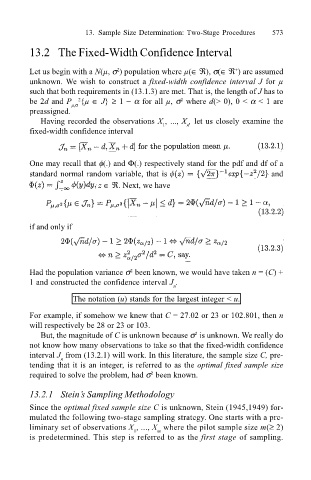Page 596 - Probability and Statistical Inference
P. 596
13. Sample Size Determination: Two-Stage Procedures 573
13.2 The Fixed-Width Confidence Interval
Let us begin with a N(µ, σ ) population where µ(∈ ℜ), σ(∈ ℜ ) are assumed
+
2
unknown. We wish to construct a fixed-width confidence interval J for µ
such that both requirements in (13.1.3) are met. That is, the length of J has to
be 2d and P µ,σ 2 {µ ∈ J} ≥ 1 − α for all µ, σ where d(> 0), 0 < α < 1 are
2
preassigned.
Having recorded the observations X , ..., X , let us closely examine the
n
1
fixed-width confidence interval
One may recall that φ(.) and Φ(.) respectively stand for the pdf and df of a
standard normal random variable, that is and
z ∈ ℜ. Next, we have
if and only if
Had the population variance σ been known, we would have taken n = (C) +
2
1 and constructed the confidence interval J .
n
The notation (u) stands for the largest integer < u.
For example, if somehow we knew that C = 27.02 or 23 or 102.801, then n
will respectively be 28 or 23 or 103.
But, the magnitude of C is unknown because σ is unknown. We really do
2
not know how many observations to take so that the fixed-width confidence
interval J from (13.2.1) will work. In this literature, the sample size C, pre-
n
tending that it is an integer, is referred to as the optimal fixed sample size
required to solve the problem, had σ been known.
2
13.2.1 Steins Sampling Methodology
Since the optimal fixed sample size C is unknown, Stein (1945,1949) for-
mulated the following two-stage sampling strategy. One starts with a pre-
liminary set of observations X , ..., X where the pilot sample size m(≥ 2)
1
m
is predetermined. This step is referred to as the first stage of sampling.

